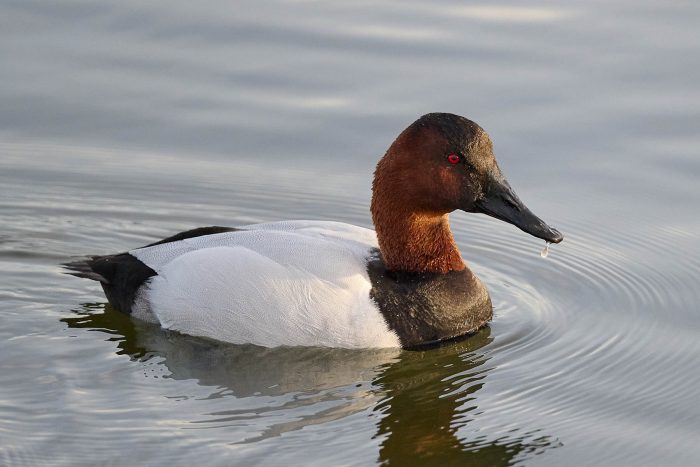Canvasback
Aythya valisineria
The canvasback is a large diving duck with a distinctive long, sloping facial profile. It visits the Chesapeake Bay and its tidal rivers from autumn through spring.
This section shows one large critter image at a time. Use the thumbnails that follow to select a specific image to display here.

This gallery contains a grid of small thumbnails. Selecting a thumbnail will change the main image in the preceding section.
Appearance
The canvasback's head slopes into its long, dark bill, giving it a distinctive silhouette. It varies in color depending on sex: males have a rusty red head and neck, a black breast, a white body and a black tail, while females have a brownish head and chest, a whitish body and a brownish tail. This duck grows 18 to 22 inches in length.
Feeding
The canvasback eats leaves, buds and roots of underwater grasses, particularly wild celery. It has adapted to feed on snails, macoma clams, insect larvae and other small invertebrates due to declining underwaters grasses in the Chesapeake Bay. It dives to find its prey.
Predators
Canvasbacks are preyed upon by bald eagles, snapping turtles, great black-backed gulls, black-crowned night herons and other large predators. Humans also hunt canvasbacks.
Flight
The canvasback takes off by running across the water’s surface. One of the fastest flying ducks, it reaches speeds of 55 miles per hour in the air. It can be identified in flight by its white body and black chest.
Voice
Males grunt or croak and females quack. Canvasbacks are usually quiet during non-breeding season.
Reproduction and life cycle
Courting begins and pairs form in early spring, before the ducks leave the Bay region for breeding grounds in North America's Prairie Pothole Region. They form nests over water, protected by marsh vegetation such as cattails and bulrushes. Females lay 8 to 10 eggs and incubate them for 24 to 29 days. After hatching, young are tended to by the female for several weeks, at which point the ducklings are left to fend for themselves until they can learn to fly (60 to 70 days old). The oldest recorded canvasback was 22 years old.
Did you know?
- The canvasback gets part of its scientific name, valisineria, from the scientific name of wild celery, Vallisneria americana, its favorite food.
- They are the largest diving duck species.
- Canvasbacks are powerful swimmers. However, like other diving ducks, they are clumsy on land because their legs are located far back on the body.
- Nearly half of North America’s canvasbacks used to winter in the Chesapeake Bay region. That figure has since declined to about 20 percent due to a decline in bay grasses, their preferred food. However, canvasback populations appear to be slowly recovering due to better protection measures.
Sources and additional information
- Life in the Chesapeake Bay by Alice Jane Lippson and Robert L. Lippson
- Chesapeake Bay: Nature of the Estuary, A Field Guide by Christopher P. White
- Animal Diversity Web: Aythya valisineria – University of Michigan Museum of Zoology
- Waterfowl ID: Canvasback – Ducks Unlimited
- All About Birds: Canvasback – The Cornell Lab of Ornithology
- Aythya valisineria – U.S. Forest Service
